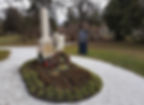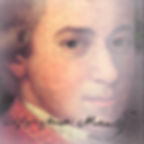Four mysteries of Mozart's death
- Steve Moretti
- Aug 31, 2018
- 5 min read
Updated: Apr 4, 2019
The musical genius from Salzburg is long gone, but some questions about his death linger to this day.
Call me naive. Or a lazy Mozart historian.
For years I pretty much took everything in the 1984 film Amadeus, as the literal truth about Wolfgang Amadeus Mozart. I always had nagging doubts about the Salieri character, but I presumed the basic facts of the life of the great composer were accurate. That changed with a trip to Austria this summer.
We visited Salzburg to see the house where Mozart was born and spent his teenage years, but it was not until our tour of Vienna that I got a rude awakening. The guide on our bus casually pointed to a park and said: “That's where Mozart is buried.”
What?
We were driving down a four-lane highway through a busy part of Vienna. Wasn’t he buried in a pauper’s grave in a dark forest far from the city? I clearly remembered that from the movie.

I challenged the guide with my superior knowledge. I mean I've watched that movie at least a dozen times. The guide shook her head. “No, he is buried right there.”
Doubting Amadeus?
Now I was left wondering about the film, in particular the account of Mozart’s death. Peter Shaffer’s Academy award-winning script (adapted from his own stage play) explored the gap between human genius and mediocrity. As a work of fiction it is a brilliant, emotionally compelling narrative. But as a documentary on Mozart, maybe not so much.
After a little digging I realized there are at least 4 mysteries surrounding his death that are still generating discussion, if not controversy, to this day.
1. Where is Mozart buried?
The accepted answer is that he was buried in a ‘common grave’ at St. Marx Cemetery a few miles outside the old city walls of Vienna. Was he buried in an open pit, as depicted in the movie or in an individual grave, as others claim? A ‘common grave’ by the way, was used for anyone at that time in Vienna who was not an aristocrat.

The day of his funeral, December 7, 1791 was dark and stormy, and got worse as the day progressed. With rain changing to snow and the storm picking up intensity, no one attended the funeral procession or the final ceremony. By some accounts his corpse was simply covered in lime and buried in a
communal grave. Others dispute this, and say he was given a ‘third class’ funeral at a cost of 8 florins. For that price, about $450 USD after inflation, he would get an individually dug grave.
However, within a few years the grave digger had died and his successor did not remember exactly where Mozart had been buried on that bleak December evening.

In 1855, a gravestone was erected at the site where ‘experts’ concluded Mozart’s grave site was located. But their conclusions were based more on conjecture than on fact.
2. Was Mozart poisoned?
This question seems to an easy one, at first. There is no evidence of poisoning, even though a Berlin newspaper declared within this to be the case a week after his death. Speculation has been running rampant ever since.

As late as November 22, 1791 he was in good health. He fell ill after a public performance in Vienna and died less than two weeks later, just before 1:00 am on the morning of December 5.
Because there was no autopsy, no medical records and no corpse, at least 118 possible causes of death have been postulated. His symptoms have been widely studied by experts and to this day, no one can make a definitive call.
Given the sudden nature of his illness and death, one theory is epidemic streptococcal infection. But without hard evidence, the cause of death remains open to debate.
3. Did Mozart work on the Requiem Mass on his deathbed?
Near the end of Amadeus, Mozart lies in bed, deathly ill. Antonio Salieri is with him, and offers assistance in finishing the Requim in D Minor. Mozart dictates whole sections to Salieiri who struggles to transcribe the notes to paper.

The scene captures Mozart's genius as he reaches into his mind, hours from death, searching for the composition that lies inside, almost fully-formed. He instructs his note-taker on how to assemble the pieces.
Salieri can barely make sense of the directions, recording the notes as fast as his quill can move, often muttering: “I don’t understand, I don’t understand.”
It seems this part of the film is loosely based on facts. Friends who were with the Mozart hours before his death, said later that he had the score of the Requiem brought to his bed. Mozart sang the alto part while others joined in singing the soprano line. He is reported to have wept at the first bars of the Lacrimosa movement.

As Mozart lay on his deathbed, he dictated sections of the Requiem to his pupil, Franz Süssmayr, the man who would go on to complete the score at the request of Mozart's widow, Constanze. While this story has been disputed by one of the friends who was with him, others do remember Mozart giving instruction to Süssmayr, while Salieri watched.
4. Was Salieri involved in the death of Mozart?
Soon after Mozart’s death, rumours began that the two had been bitter rivals and that Salieri poisoned the younger composer. This lead to a play entitled Mozart and Salieri, focusing on the dangers of envy. The play became an opera. Both included the poisoning theory.

In Amadeus, the ‘poison’ is Salieri’s manipulation of Mozart, playing on the composer’s troubled relationship with his dead father. Salieri secretly commissions Mozart to write a mass for the dead, ominously telling him that it is for “a man who deserved a requiem mass. And never got one.”
It is true that Mozart was commissioned to write a requiem mass. Count Franz Walsegg-Stuppach was a wealthy landowner who had just lost his young wife died. He commissioned Mozart to write a requiem mass that he would pass off as his own, sending masked messengers to offer the commission and deliver generous cash payments.
Salieri suffered a mental breakdown in later life, driven in part by the accusation that he poisoned Mozart, a claim which greatly troubled him. After being admitted to the Vienna General Hospital, Salieri accused himself of killing Mozart and eventually this became woven into almost all future accounts of their relationship.
Google loves this story...
If you are at all curious about the mysteries of Mozart’s death, you can spend the better part of a day researching the competing theories, studies and papers written on the subject.
Together with plays, operas, movies, and documentaries, you get a sense that the ongoing fascination with these mysteries will continue for a long time to come.
